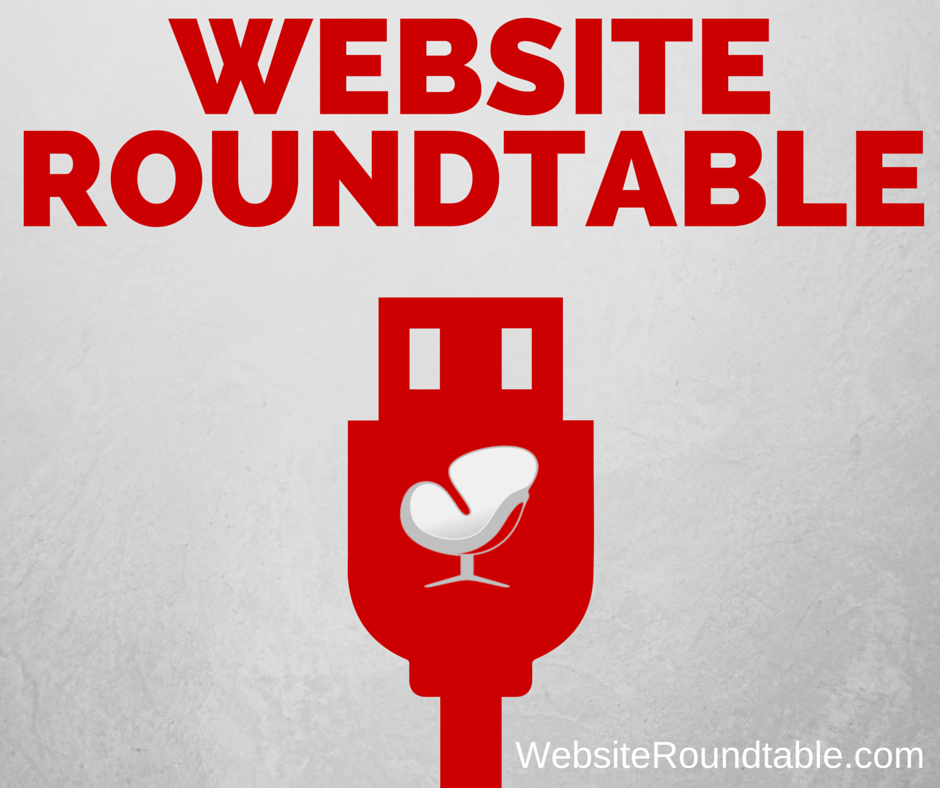Podcast: Play in new window | Download | Embed
Welcome to Day 5 How to create a website, step-by-step
In this final website roundtable podcast, we’re going to be covering start to finish how to do a website. We’ve covered a lot of information in this podcast and I thought we’d do a summary. We’re going to take you through the big bullet points of creating a website.
Ever wonder how to use WordPress? Today you get the step-by-step WordPress tutorial.
Don’t forget, you can hear all five days and download the whole book, transcripts, and walk through over at www.WebsiteRoundtable.com
Website Roundtable Bios
Joseph R. Sanok
 Joe is a private practice consultant and the owner of Mental Wellness Counseling in Traverse City, MI. He has had terrible website and great websites! Joe researched how to use WordPress and took the long route! He wishes he had this Wordpress tutorial.
Joe is a private practice consultant and the owner of Mental Wellness Counseling in Traverse City, MI. He has had terrible website and great websites! Joe researched how to use WordPress and took the long route! He wishes he had this Wordpress tutorial.
Aaron Carpenter
 Aaron Carpenter owns Legendary Lion Web Design. They’re based out of Traverse City, Michigan and do custom web development. They try to give people the most value for their coin on making custom website applications.
Aaron Carpenter owns Legendary Lion Web Design. They’re based out of Traverse City, Michigan and do custom web development. They try to give people the most value for their coin on making custom website applications.
Perry Rosenbloom
 Perry Rosenbloom is the founder of Brighter Vision. Brighter Vision is an all-in-one website solution for therapists so they build therapists’ websites that look like they’ve spent a few thousand dollars but in fact only cost them $59 a month. They do a fully custom website for you, with support and all of your SEO, for just a low monthly cost.
Perry Rosenbloom is the founder of Brighter Vision. Brighter Vision is an all-in-one website solution for therapists so they build therapists’ websites that look like they’ve spent a few thousand dollars but in fact only cost them $59 a month. They do a fully custom website for you, with support and all of your SEO, for just a low monthly cost.
If you want the full transcripts, screenshots, and checklists to help you start building your counseling website, click the image below and we’ll email you the 50 page e-book for free!
Scroll Below for Today’s How to Start a Website Transcript
DAY 5 website creation how to use WordPress step-by-step
In this final chapter, we’re going to be covering start to finish how to do a website. We’ve covered a lot of kind of information in this book and I thought we’d do a summary. We’re I’m going to take you through the big bullet points of creating a website.
Big Picture Overview Checklist
Figure out your domain, is it available?
I usually use Namecheap but there are lots of great options out there so you find your domain, then:
Figure out your hosting
I usually use BlueHost but there’s like we said earlier on during the week, a lot of different options there. Here are some screenshots to help. Here’s you Wordpress tutorial.
So then:
Link your URL to your hosting
Install WordPress
Figure a theme in WordPress
Make it look pretty from the theme. Add new theme.
Build pages: This is the content of your site such as Home, About, Services, Counseling Blog, and Contact Us
Start blogging
Blog around whoever my specific market.
Things to Ask Yourself
I guess the big thing to decide is:
Am I going to bootstrap this or am I going to hire help and if I’m going to hire help how much help do I want to hire?
Outsource parts of the project to: Upwork, Fiverr or 99designs?
Hire a professional like Legendary Lion or Brighter Vision
I think something to really keep in mind is what is your overall goal? Who are your target clientele? And crafting your copy and crafting your bootstrap design to resonate with them. Think about what actions they want people to take that you want people to take. Think about colors that you think would resonate with people and focus on that kind of strategy to really get people engaged in your website and ultimately contact you.
Return on Investment of Time and Money
When I first launched Mental Wellness Counseling, it was my side gig. I had my full-time job, I was poking around in WordPress and hosting. I’m really glad that I bootstrapped it for a while. But I probably bootstrapped it too long and lost some clients because my website I built wasn’t beautiful.
First, what’s ROI?
ROI (Return on Investment) is forecasting what you expect to get back on your investment. For example, if you pay for advertising, how many clients do you need to get to make the advertising worth it. In building your website, it’s important to know how to spend your time.
Here are examples of investments you may want to know the ROI:
Consulting services
Advertising
Marketing
Investing in a website
In calculating your ROI, you want to have a few items/numbers.
Average Number of Sessions: This is the number of sessions that an average client sees you. How long is it from the intake until discharge? 5 sessions? 10 sessions? 7.8 sessions?
Average Rate: On average, how much is your rate per session? If you take insurance, you’ll want to try and average out your reimbursement. A great way to figure this out is:
How many sessions did you do last month?
What was the gross revenue for the practice?
Divide
For example, if you had 50 sessions last month and your gross revenue (before expenses) was $5,000, then take $5,000/50 = $100 per session
Total Sessions per Week: On average, how many counseling or consulting sessions did you have per week? For example:
Week 1: 14 sessions
Week 2: 19 sessions
Week 3: 22 sessions
Week 4: 12 sessions
Total sessions: 14 + 19 + 22 + 12 = 67 sessions
67/4 weeks = 16.75 sessions on average per week
Monthly Expenses: This is pretty straight-forward, what do you spend money on every month?
Investment Opportunity
So this is where it might get confusing. Here are some examples of investments you would want to find an ROI:
Private Practice Consulting: If you are bringing on a private practice consultant you definitely want to have a good idea of when you can pay yourself back for that investment of time and money. Say consulting was going to cost $2,380 over a 4 month time period ($595/month) that would be your first number in the ROI calculator.
Advertising: Maybe you listened to my podcast with Dan Wendler and you are doing some Google ads. Maybe you budget $500 for that advertising campaign. Or a local newspaper says you can buy an ad for $750.
Website: Maybe after reading all this, you’ve decided you don’t want to build your own website.
Expected New Clients
This is where you can play with the numbers. If you get 1 new client, how long will it take to pay yourself back? What if you get 3 or 10, when is it really worth the investment?
I have a full ROI calculator that you can use to figure out how long it will take to pay yourself back for any investment!
Here’s the link to the ROI Calculator.
Final Checklist
Let’s go through the quick website checklist:
Buy your URL (this will be part of your hosting with Bluehost): It might be tempting to use your name, but long term, it could pigeon-hole you. So I would not recommend using your name because if you grow and as you grow and you add additional therapists to work for you that’s going to limit you or you’re going to have to change your domain name. So I would avoid using your domain name and instead, using a little more generic, a little more brandable or utilize a geographic domain name such as your location plus counseling or plus therapy or something like that. If you can get it go with the dot com.
Get hosting: It doesn’t really matter who you go. Just make sure that you’re real comfortable with their support. And the best way to do that is to call them and see. Call them as though you’re a client and request support and just see how long it takes. If you email them, how, what’s their average support response time? Here’s a link to get Bluehost.
Pick out your theme: I’d avoid Themeforest and stick with a framework such as Genesis/studio press personally (Perry). ThemeForest can be designed to look pretty but if you’re going WordPress I can’t speak highly enough of studio press and the themes they have there. You can get a really great site, really well-designed theme from studio press that’s functional and is built with a solid code framework in mind. Take something where most of the road is paved. Save yourself a headache later by needing to do a lot of changing to whatever you’re starting with. So feel free to spend a little extra time looking around until you find something that you feel like it’s a 95% good feel like you’re almost there and you just need to add your content logo and a few things.
Content Creation: Use other blogs for inspiration. Look at them, read those and then maybe even set aside some time to read some blogs that you’re comfortable with. Then keep a notepad or maybe a text file on your desktop somewhere where you write down ideas as you get them so you don’t forget them for topics. Then revisit them when you have time to write your blog post. With blogging either commit or don’t do it. Commit to a schedule. It doesn’t have to be multiple times a week. It doesn’t even have to be once a week. It could even be once a month, but pick a schedule and commit to it. Otherwise, you’re just going to waste your time. So commit to blogging if you’re going to go down that path.

